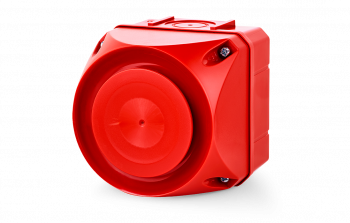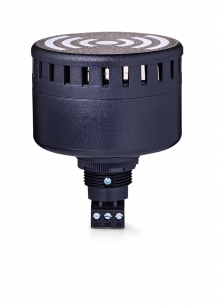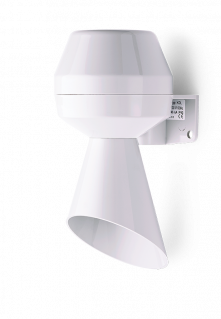Audible alarms
About Auer Signal
Auer Signal is a global leading manufacturer of signaling technology, operational in 70+ countries. The company produces stack lights, visual-, audible-, visual-audible and explosion proof signaling devices.
Discover Signaling Devices NOW!What is an audible alarm?
Audible alarms produce loud noises and are used to draw attention to an upcoming action. Mostly, audible alarms serve to warn of imminent dangers in areas where visual indications cannot be used sufficiently to alert people. Those dangers could be trucks backing up or gates closing.
Audible alarms can be generated by audible signaling devices, but also by instruments or people. Audible alarms are, for example, used in fire alarm systems or security systems.
What is sound and how is it created?
A sound is an even, consistent vibration of the air (another medium can also be water or metal) that is perceived by the ear of the listener.
If air starts to move, this is called a surge wave and sounds are created. Sound waves are longitudinal waves, which means that the vertical orientation of the particles does not change. In an audible signaling device, for example, a membrane vibrates, causing air to move and sound. In airless spaces, for example in a vacuum and also in outer space, sounds can be produced, but the sound does not propagate. The speed of sound in air is about 340 meters per second.
Compared to a sound, a bang, for example, is a short and strong vibration. A sound is composed of several tones that sound simultaneously and overlap. A noise, on the other hand, consists of uneven vibrations and frequencies.
What is a “pitch”?
Whether we hear a high- or low-pitched sound depends on the number of vibrations per second (frequency). The higher the frequency of the vibrations, the higher the sound.
Low pitched sounds range between 50 Hz and 100 Hz for the human ear. High-pitched tones are at a frequency of 2000 Hz to 5000 Hz. Depending on the age and functionality of the hearing, the lowest perceived sounds (hearing threshold) can be at 16 Hz, the highest at 20000 Hz. If the frequency of a sound is below 20 Hertz, that sound is then called “infrasound”.
What is frequency?
The number of times per second that a soundwave repeats itself is called frequency. It is measured in Hertz (abbreviated Hz).
Hz = number of uninterrupted cycles per second
1 Hz = one cycle per second
Comparing two waves of the same wavelength, a higher frequency is associated with faster movement. Comparing two waves of different wavelengths, a higher frequency doesn't always indicate faster movement, although it can. Waves of different wavelengths can have the same frequency.
HOW IS SOUND VOLUME CREATED?
The volume of a sound perceived by the human ear depends on the amplitude of the vibrations. The amplitude is the size of an oscillation that emanates from a sound. The higher the amplitude, the louder the sound.
USAGE AND VOLUME OF VARIOUS TYPES OF ALARMS
The different signal sounds have different ranges depending on the type of sounder, signal type and volume setting:
Find out more about volume in signaling.
What types of signal tones exist?
The acoustic signaling devices from Auer Signal have a variety of different signal tones. The ASL multi-tone siren can play 63 types of tone.
The most important types of signal tones are explained in the table below:
| Tonality | Piktogramm | Frequency | Description | Type of application |
| Continuous tone |  | 660 | A continuous tone is a constant tone that does not change its pitch. | Alarm Sweden |
| Pulsating sound |  | 420 | A pulsating tone is a continuous tone with short, periodic pauses. | Alarm Australia AS1670 |
| Alternating tone |  | 440-554 | The alternating tone plays alternating higher and lower tones. | Alarm Sweden |
| Rising tone |  | 500-1200 | The rising tone becomes higher over time, followed by a short pause. After the pause, the tone is again slightly lower and then becomes higher again. | Evacuation Australia AS2220 |
| Slowly rising tone |  | 500-2400 | The slowly rising tone gradually becomes higher as it progresses, and then remains unchanged at the highest note. | |
| Falling tone |  | 1200-500 | The falling tone becomes lower over time, followed by a short pause. After the pause, the tone is again slightly higher and then becomes lower again. | Evacuation Germany DIN 33404-3 |
| Alarm |  | 2000-10 | The alarm tone is a pulsating tone, with a very high pulse-to-pause ratio. | |
| Gong |  | 970-800 | The gong plays three different sounds and then repeats again. |
Download interactive tone table
What types of audible signaling devices exist?
At Auer Signal we distinguish between electronic and electromechanical sounders:
ELECTRONIC SOUNDERS
In electronic sounders, the signal tone is generated electronically by a microprocessor, amplified and emitted via a loudspeaker. In smaller devices, sound capsules are used as loudspeakers; in more powerful devices, pressure chamber loudspeakers or classic loudspeakers are used.
Since the acoustic signal is generated electronically, the electronic sounders from Auer Signal can produce a wide variety of tones and frequencies. The advantage here is that many different types of tone are available and thus several well-distinguishable signaling signals can be assigned to different meanings or areas of application. Customized special solutions are also possible for the tones.
In addition to the signal tones, the volume of the electronic sounders and multi-tone sirens can also be individually adjusted on most Auer Signal devices.
Electronic sounders from Auer Signal:
- Multi-tone sirens
- Piezo buzzer as built-in and surface-mounted buzzer
ELECTROMECHANICAL SOUNDERS
Electromechanical horns and bells are classics among acoustic signaling devices. They do not generate the signal tone via a sound membrane.
Electromechanical sounders from Auer Signal:
- Horns (small horns or large signal horns)
WHAT IS A MULTI-TONE ALARM SOUNDER?
The multi-tone sounder generates the signal tones with a loudspeaker and an electronic amplifier. The big advantage over mechanical sounders is the flexibility of use thanks to several different types of sound. In addition, the volume can be better regulated.

WHAT IS A PIEZO BUZZER?
Piezo buzzers have a piezo disc built into the inside, which consists of piezo crystals. They change their shape when voltage is applied, like a membrane. This property is exploited by placing the piezo crystals on a brass disc and applying voltage to them at short intervals. This causes the crystals on the disc to vibrate, which generates sound. Frequencies of up to 4000 Hz are achieved. In general, piezo buzzers can achieve high tones from 2000 Hz, low tones cannot be produced.
With a special measure in the construction based on the resonance principle, piezo buzzers from Auer Signal achieve very high sound pressures.
The advantages of the piezo buzzer are its small design, low power consumption and it is also relatively inexpensive.

WHAT IS AN ALARM HORN?
In an alarm horn, the magnetic force of a coil moves a clapper that strikes a metallic diaphragm at a frequency of 100 to 150 Hz. This produces the typical low-frequency and easily recognizable horn sound. Auer Signal has horns without and with funnel in its product range.







 ()
()
